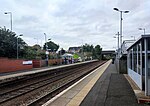Pitreavie Castle
17th-century establishments in ScotlandCastles in FifeCategory A listed buildings in FifeHouses completed in the 17th centuryHouses in Fife ... and 2 more
Listed castles in ScotlandUse British English from May 2013

Pitreavie Castle is a country house, located between Rosyth and Dunfermline in Fife, Scotland. It was built in the early 17th century, and was extensively remodelled in 1885. The house remained in private hands until 1938, when it was acquired by the Air Ministry, and became RAF Pitreavie Castle. The RAF station closed in 1996, and the building was converted into residential apartments. In 1986, the large underground cellar was still operated by the RAF as the Command and Control Centre of the then Northern Command for dispatching and coordinating all air and maritime search and rescue assets, primarily RAF aircraft over the North Sea area.
Excerpt from the Wikipedia article Pitreavie Castle (License: CC BY-SA 3.0, Authors, Images).Pitreavie Castle
Castle Brae, Dunfermline Pitreavie
Geographical coordinates (GPS) Address Nearby Places Show on map
Geographical coordinates (GPS)
| Latitude | Longitude |
|---|---|
| N 56.048422222222 ° | E -3.4169555555556 ° |
Address
Castle Brae
Castle Brae
KY11 8PF Dunfermline, Pitreavie
Scotland, United Kingdom
Open on Google Maps









